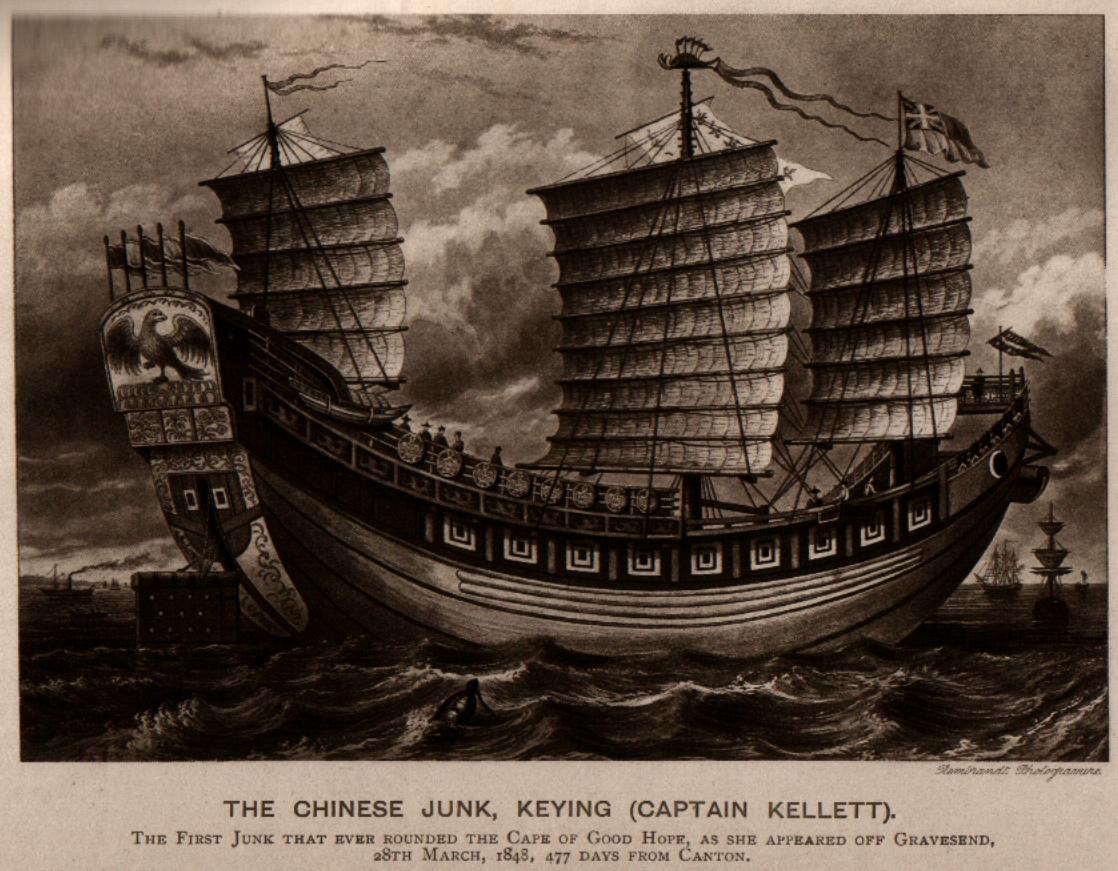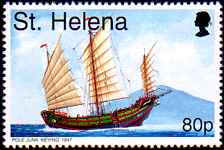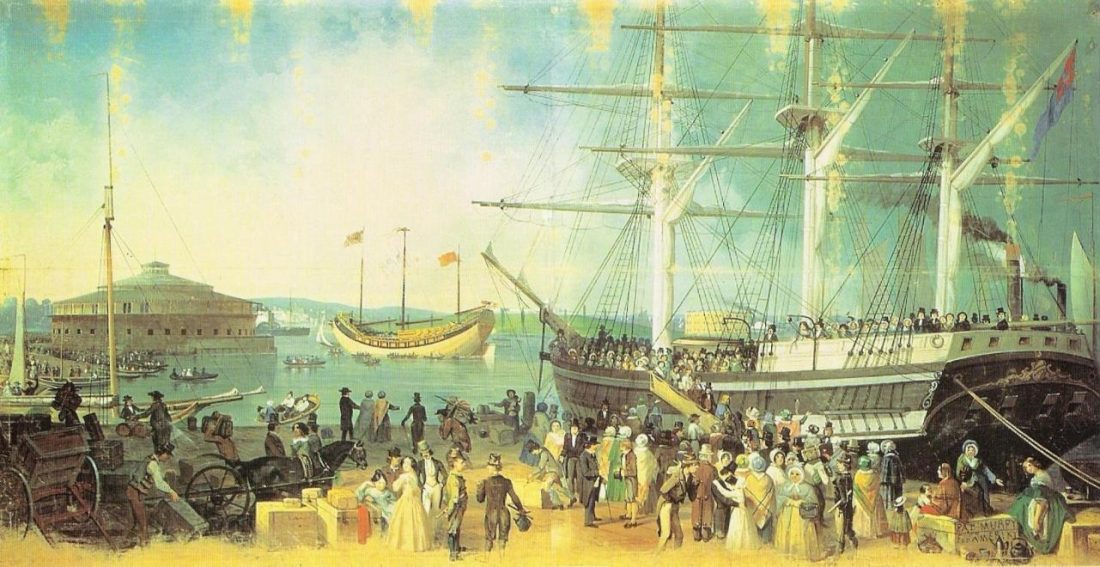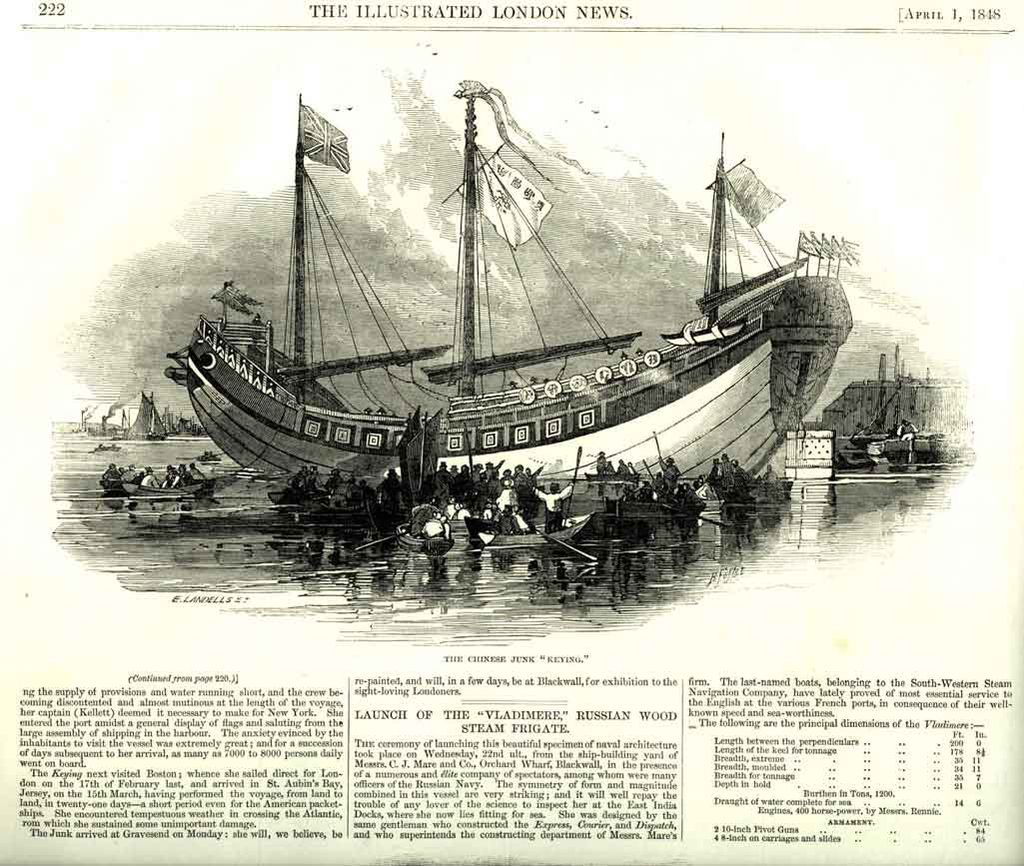The Intercontinental Junk Keying, 1846
In a 1912 book entitled “The Sea Trader – His Friends and Enemies” I came across the engraving illustrated here. I found it wholly fascinating as it refers to the Keying, “The first junk that ever rounded the Cape of Good Hope, as she appeared off Gravesend, 28th March 1848, 477 days from Canton”

My interest aroused, I Googled “Junk Keying” and found a fascinating Wikipedia entry that’s well worth reading and which has further illustrations of the junk, one of which is a coloured, and more delicate, version of the above.

It appears that she was a three-masted, 800-ton, 160 foot long Foochow trading junk and her purchase in secrecy by British businessmen in Hong Kong was in defiance of a Chinese law that prohibited purchase of Chinese vessels by foreigners. Under the command of a Captain Charles Alfred Kellett, she was manned by 12 British and 30 Chinese seamen.
 She sailed not only to Britain but to the United States, though it’s not clear what cargo, if any, she was carrying. She left Canton/Hong Kong in December 1846, putting in at St.Helena in April 1847, an event commemorated in more recent years by a stamp issued by the island,reaching New York in July 1847 where she could be viewed for 25 cents per head.
She sailed not only to Britain but to the United States, though it’s not clear what cargo, if any, she was carrying. She left Canton/Hong Kong in December 1846, putting in at St.Helena in April 1847, an event commemorated in more recent years by a stamp issued by the island,reaching New York in July 1847 where she could be viewed for 25 cents per head.

Keying moored in New York Harbor in 1847 by Samuel Waugh (1814–1885)
(Acknowledgement to Museum of the City of New York, public domain)
The Keying remained in New York until sailing on to Boston by November 1847. In the following spring she sailed on to Britain, arriving in April 1848. She proved herself to be an excellent sea-boat and she made the Transatlantic crossing in 21 days, which was considered fast even by the standards of American packets. Her arrival off Jersey in the Channel Islands, evoked such interest that one sightseeing bot sailed so close as collide with her, several of the occupants, including a naval officer, being drowned.
On arrival in London she was again opened to the public. Queen Victoria – the first woman to have been allowed on board, was among the visitors, as were the aged Duke of Wellington and Charles Dickens.

Coverage in the Illustrated London News of the Keying’s arrival in London
Mention of Dickens led me to find out whether he had written about it – he was a prolific journalist as well as a novelist. I discovered that in 1848 Dickens based a scathing attack in Chinese culture and history on his visit to the Keying. His article in the Examiner, a Sunday newspaper considered to be a leading intellectual journal, was a more nasty piece of work than one would expect from an author so publicly dedicated to general benevolence (though not in relation to his own wife) and it does Dickens little credit. He described the Keying as a “floating toyshop” and that “the best that (Chinese) seamanship can do for a ship is to paint two immense eyes on her bows, in order that she may see her way… and to hang out bits of red rag in stormy weather to mollify the wrath of the ocean.” Dickens did not recognise the Keying as a seaworthy vessel capable of long ocean voyages, but rather the embodiment of a stagnant cultural climate. He concluded that “Thousands of years have passed away, since the first Chinese junk was constructed on this model; and the last Chinese junk that was ever launched was none the better for that waste and desert of time.”
The Keying never left Britain, being towed to Liverpool, where she might also have been considered an attraction, and there she rotted away.
Click here to return to the “Steam, Steel and Strife” archive
